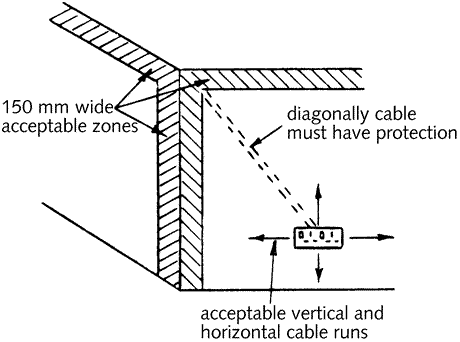4.4.1 Cable supports and protection
Cables must be fixed securely at intervals
which are close enough to ensure that there will be no excessive
strain on the cable or on its joints and terminations, and
to prevent cable loops appearing which could lead to mechanical
damage. {Table 4.10} indicates minimum acceptable spacings
of fixings for some common types of cables.
Table 4.10 Maximum spacing
for cable supports
|
Overall cable
|
p.v.c. sheathed
|
Mineral insulated
|
|
diameter
|
Horizontal
|
Vertical
|
Horizontal
|
Vertical
|
|
(mm)
|
(mm)
|
(mm)
|
(mm)
|
(mm)
|
|
up to 9
|
250
|
400
|
600
|
800
|
|
10 to 15
|
300
|
400
|
900
|
1200
|
|
16 to 20
|
350
|
450
|
1500
|
2000
|
|
21 to 40
|
400
|
550
|
2000
|
3000
|
Where cable runs are neither
vertical nor horizontal, the spacing depends on the angle
as shown in {Fig 4.11}.
Where a cable is flat in cross-section
as in the case of a p.v.c. insulated and sheathed type,
the overall diameter is taken as the major axis as shown
in {Fig 4.12}.
Fig 4.11 Spacing of support
clips on angled runs
Fig 4.12 Effective diameter
of a flat cable
The Regulations are concerned to protect
hidden cables from damage. Thus, where cables are run beneath
boarded floors, they must pass through holes drilled in
the joists which are at least 50 mm below the top surface
of the joist. This is to prevent accidental damage due to
nails being driven into the joists. The hole diameters must
not exceed one quarter of the depth of the joist and they
must be drilled at the joist centre (the neutral axis).
Hole centres must be at least three diameters apart, and
the holes must only be drilled in a zone which extends 25%
to 40% of the beam length from both ends.
An alternative is to protect the cable
in steel conduit. It is not practicable to thread rigid
conduit through holes in the joists, so the steel conduit
may be laid in slots cut in the upper or lower edges as
shown in {Fig 4.13}. The depth of the slot must be no greater
than one eighth of the joist depth and notches must be in
a zone extending from 10% to 25% of the beam length from
both ends.
Fig 4.13 Support and
protection for cables run under floors
Where cable runs are concealed behind plaster
they must he installed in 'acceptable zones' which are intended
to reduce the danger to the cables and to people who drill
holes or knock nails into walls. Cable runs must only follow
paths which are horizontal or vertical from an outlet, or
be within 150 mm of the top (but not the bottom) of the
wall, or within 150 mm of the angle formed by two adjoining
{Fig 4.14} Acceptable
installation zones for concealed cables. The diagonal cable
must be enclosed in earthed metal walls. Where a cable run
has to be diagonal, it must be protected by being enclosed
in steel conduit, or must be a cable with an earthed metal
sheath (such as mineral insulated cable), or an insulated
concentric cable. In this latter case, the phase conductor
will be surrounded by the neutral, so that if a nail or
a screw penetrates the cable it will be impossible for it
to become live. The possible zones are shown in (Fig 4.14).
The internal partition walls of some modern buildings are
very thin, and where cables complying with the requirements
above are within 50 mm of the surface on the other side,
they will require protection.
 |
Fig 4.14 Acceptable installation
zones for concealed cables. The diagonal cable must be enclosed
in earthed metal.
There are cases where cables are enclosed
in long vertical runs of trunking or conduit. The weight
of the cable run, which effectively is hanging onto the
top support, can easily cause damage by compressing the
insulation where it is pulled against the support. In trunking
there must be effective supports no more than 5 m apart,
examples of which are shown in Fig 4.15, whilst for conduit
the run must be provided with adaptable boxes at similar
intervals which can accommodate the necessary supports.
Fig 4.15 Support for
vertical cables in trunking
The top of a vertical conduit or trunking
run must have a rounded support to reduce compression of
insulation. The diameters required will be the same as those
for cable bends given in {4.4.2}.
Support for overhead conductors is considered
in {7.13}.